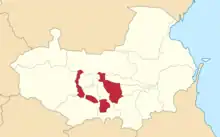Sunzhensky otdel
The Sunzhensky otdel[lower-alpha 1] was a Cossack district (otdel) of the Terek oblast of the Caucasus Viceroyalty of the Russian Empire. The area of the Sunzhensky otdel makes up part of the North Caucasian Federal District of Russia. The Sunzhensky otdel was eponymously named for its administrative center, Sunzhenskaya (present-day Sunzha).[1]
Sunzhensky otdel
Сунженскій отдѣлъ | |
|---|---|
 Location in the Terek Oblast | |
| Country | Russian Empire |
| Viceroyalty | Caucasus |
| Oblast | Terek |
| Established | 1888 |
| Abolished | 1920 |
| Capital | Sunzhenskaya (present-day Sunzha) |
| Area | |
| • Total | 22,694.30 km2 (8,762.32 sq mi) |
| Population (1916) | |
| • Total | 74,505 |
| • Density | 3.3/km2 (8.5/sq mi) |
| • Rural | 100.00% |
Administrative divisions
The subcounties (uchastoks) of the Sunzhensky otdel were as follows:[2]
| Name | 1912 population |
|---|---|
| 1-y uchastok (1-й участокъ) | 26,148 |
| 2-y uchastok (2-й участокъ) | 32,511 |
Demographics
Russian Empire Census
According to the Russian Empire Census, the Sunzhensky otdel had a population of 115,370 on 28 January [O.S. 15 January] 1897, including 58,502 men and 56,868 women. The majority of the population indicated Ingush to be their mother tongue, with significant Russian and Kabardian speaking minorities.
| Language | Native speakers | % |
|---|---|---|
| Ingush | 46,214 | 40.06 |
| Russian | 42,013 | 36.42 |
| Kabardian | 16,088 | 13.94 |
| Ukrainian | 3,891 | 3.37 |
| Kumyk | 2,349 | 2.04 |
| Chechen | 1,906 | 1.65 |
| Ossetian | 871 | 0.75 |
| German | 732 | 0.63 |
| Georgian | 403 | 0.35 |
| Belarusian | 233 | 0.20 |
| Polish | 146 | 0.13 |
| Armenian | 97 | 0.08 |
| Tatar[lower-alpha 2] | 85 | 0.07 |
| Imeretian | 61 | 0.05 |
| Romani | 60 | 0.05 |
| Avar-Andean | 47 | 0.04 |
| Kazi-Kumukh | 41 | 0.04 |
| Circassian | 25 | 0.02 |
| Bashkir | 22 | 0.02 |
| Jewish | 18 | 0.02 |
| Persian | 11 | 0.01 |
| Dargin | 9 | 0.01 |
| Romanian | 8 | 0.01 |
| Nogai | 5 | 0.00 |
| Greek | 3 | 0.00 |
| Other | 32 | 0.03 |
| TOTAL | 115,370 | 100.00 |
Kavkazskiy kalendar
According to the 1917 publication of Kavkazskiy kalendar, the Sunzhensky otdel had a population of 74,505 on 14 January [O.S. 1 January] 1916, including 37,527 men and 36,978 women, 64,420 of whom were the permanent population, and 10,085 were temporary residents:[5]
| Nationality | Number | % |
|---|---|---|
| Russians | 74,007 | 99.33 |
| Georgians | 185 | 0.25 |
| Armenians | 138 | 0.19 |
| North Caucasians | 87 | 0.12 |
| Other Europeans | 62 | 0.08 |
| Sunni Muslims[lower-alpha 3] | 26 | 0.03 |
| TOTAL | 74,505 | 100.00 |
Notes
-
- Russian: Сунженский отдел, pre-reform orthography: Сунженскій отдѣлъ, romanized: Sunzhensky otdel
- Ingush: Шолжа отдел, romanized: Sholzha otdel
- Before 1918, Azerbaijanis were generally known as "Tatars". This term, employed by the Russians, referred to Turkic-speaking Muslims of the South Caucasus. After 1918, with the establishment of the Azerbaijan Democratic Republic and "especially during the Soviet era", the Tatar group identified itself as "Azerbaijani".[3][4]
- Primarily Turco-Tatars.[6]
References
- Tsutsiev 2014.
- Кавказский календарь на 1913 год, pp. 180–187.
- Bournoutian 2018, p. 35 (note 25).
- Tsutsiev 2014, p. 50.
- Кавказский календарь на 1917 год, pp. 226–237.
- Hovannisian 1971, p. 67.
Bibliography
- Bournoutian, George A. (2018). Armenia and Imperial Decline: The Yerevan Province, 1900–1914. Milton Park, Abingdon, Oxon: Routledge. ISBN 978-1-351-06260-2. OCLC 1037283914.
- Hovannisian, Richard G. (1971). The Republic of Armenia: The First Year, 1918–1919. Vol. 1. Berkeley: University of California Press. ISBN 978-0520019843.
- Кавказский календарь на 1913 год [Caucasian calendar for 1913] (in Russian) (68th ed.). Tiflis: Tipografiya kantselyarii Ye.I.V. na Kavkaze, kazenny dom. 1913. Archived from the original on 19 April 2022.
- Кавказский календарь на 1917 год [Caucasian calendar for 1917] (in Russian) (72nd ed.). Tiflis: Tipografiya kantselyarii Ye.I.V. na Kavkaze, kazenny dom. 1917. Archived from the original on 4 November 2021.
- Tsutsiev, Arthur (2014). Atlas of the Ethno-Political History of the Caucasus (PDF). Translated by Nora Seligman Favorov. New Haven: Yale University Press. ISBN 9780300153088. Archived (PDF) from the original on 17 June 2023.